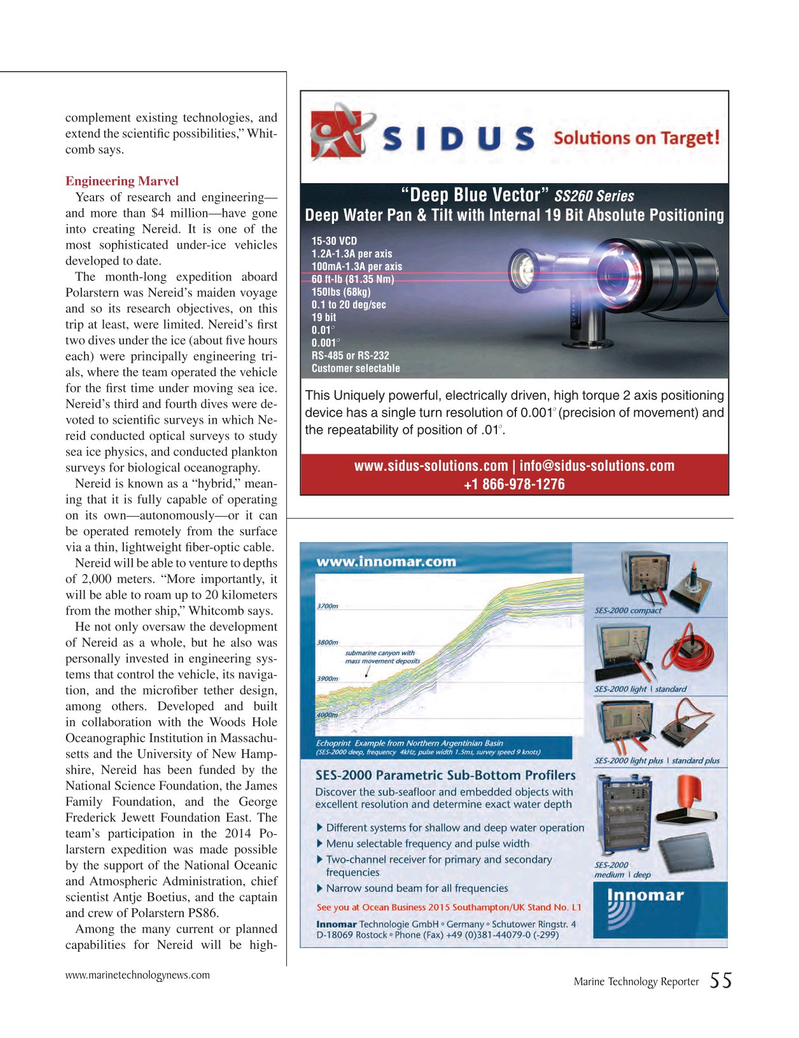
Page 55: of Marine Technology Magazine (March 2015)
Oceanographic Instrumentation: Measurement, Process & Analysis
Read this page in Pdf, Flash or Html5 edition of March 2015 Marine Technology Magazine
complement existing technologies, and extend the scienti? c possibilities,” Whit- comb says.
Engineering Marvel “Deep Blue Vector” SS260 Series
Years of research and engineering— and more than $4 million—have gone
Deep Water Pan & Tilt with Internal 19 Bit Absolute Positioning into creating Nereid. It is one of the 15-30 VCD most sophisticated under-ice vehicles 1.2A-1.3A per axis developed to date.
100mA-1.3A per axis
The month-long expedition aboard 60 ft-lb (81.35 Nm) 150lbs (68kg)
Polarstern was Nereid’s maiden voyage 0.1 to 20 deg/sec and so its research objectives, on this 19 bit trip at least, were limited. Nereid’s ? rst 0 0.01 0 two dives under the ice (about ? ve hours 0.001
RS-485 or RS-232 each) were principally engineering tri-
Customer selectable als, where the team operated the vehicle for the ? rst time under moving sea ice.
This Uniquely powerful, electrically driven, high torque 2 axis positioning
Nereid’s third and fourth dives were de- 0 device has a single turn resolution of 0.001 (precision of movement) and voted to scienti? c surveys in which Ne- 0 the repeatability of position of .01. reid conducted optical surveys to study sea ice physics, and conducted plankton www.sidus-solutions.com | [email protected] surveys for biological oceanography.
Nereid is known as a “hybrid,” mean- +1 866-978-1276 ing that it is fully capable of operating on its own—autonomously—or it can be operated remotely from the surface via a thin, lightweight ? ber-optic cable.
Nereid will be able to venture to depths of 2,000 meters. “More importantly, it will be able to roam up to 20 kilometers from the mother ship,” Whitcomb says.
He not only oversaw the development of Nereid as a whole, but he also was personally invested in engineering sys- tems that control the vehicle, its naviga- tion, and the micro? ber tether design, among others. Developed and built in collaboration with the Woods Hole
Oceanographic Institution in Massachu- setts and the University of New Hamp- shire, Nereid has been funded by the
National Science Foundation, the James
Family Foundation, and the George
Frederick Jewett Foundation East. The team’s participation in the 2014 Po- larstern expedition was made possible by the support of the National Oceanic and Atmospheric Administration, chief scientist Antje Boetius, and the captain and crew of Polarstern PS86.
Among the many current or planned capabilities for Nereid will be high- www.marinetechnologynews.com
Marine Technology Reporter 55
MTR #2 (50-65).indd 55 MTR #2 (50-65).indd 55 3/10/2015 9:06:21 AM3/10/2015 9:06:21 AM

 54
54

 56
56
